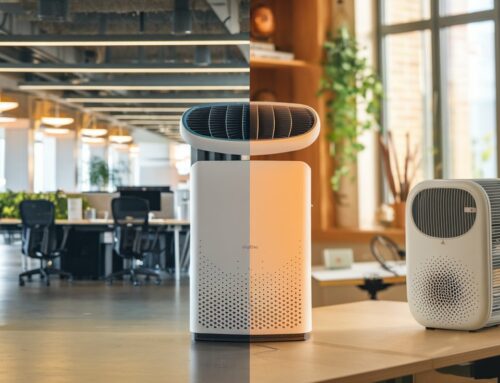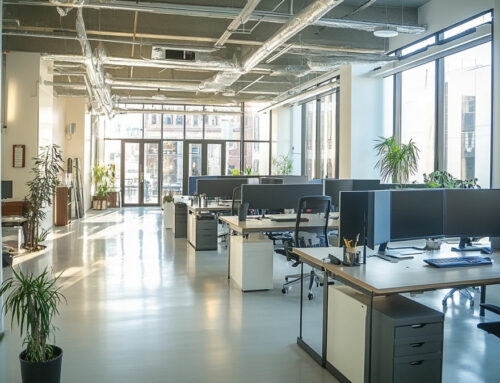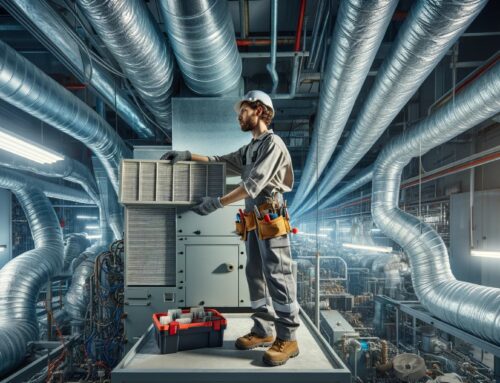February 23, 2024
Air Quality in Montreal Offices: A Comprehensive Guide

In our bustling city, the air we breathe inside our offices can be worlds apart from the fresh breezes outside. We’ve all experienced it – stepping from the crisp air of Montreal into a workspace that feels stuffy and stale. It’s not just about comfort; it’s about health, productivity, and well-being too. That’s why we’re diving deep into the topic of air quality in Montreal offices. Together, let’s explore how what’s invisible to us can have such a visible impact on our daily lives at work. From understanding pollutants to uncovering solutions that keep our indoor environments as invigorating as a walk in Parc Jean-Drapeau, we’re on this journey together.
Understanding Indoor Air Quality
Health Symptoms
We’ve all been there. One day, you’re feeling fine, and then suddenly, headaches start creeping in during work hours. Or maybe some of us notice a persistent cough that wasn’t there before. These are common signs pointing to poor air quality in our offices.
Recognizing these early symptoms is crucial for us. It helps us understand when the environment might be affecting our health. There’s a clear link between the air we breathe indoors and respiratory issues like asthma or allergies getting worse.
Productivity Impact
Ever noticed how on some days, focusing on tasks feels harder than usual? This could be due to the air quality in our Montreal offices. Studies show clean air can boost our concentration and overall output at work.
The connection between good air quality and fewer sick days is strong too. When we breathe better air, we’re less likely to catch colds or other illnesses that keep us home from work. And let’s not forget about productivity loss costs due to poor air conditions—it hits hard on any company’s bottom line.
Sick Buildings Effects
“Sick Building Syndrome” sounds like something out of a sci-fi movie but it’s very real for many of us working in Montreal offices. This syndrome includes symptoms like eye irritation, headaches, fatigue—all because of the buildings we spend hours in each day.
Here are typical signs associated with sick buildings:
-
Dry or itchy skin
-
Dizziness
-
Nausea
Improving ventilation plays a key role in fighting against these building-related illnesses. Ensuring fresh air circulates properly can make a big difference in how we feel physically and mentally while at work.
Importance of Air Quality in Offices
Employee Well-being
We all want to feel good at work. The air we breathe plays a big part in that. Good air quality can make us happier and healthier. We’ve seen how stuffy offices make people feel tired and grumpy.
Regular checks on the air can keep it fresh. This is something every office should do. It’s like making sure we’re eating healthy food but for our lungs.
Adding plants around the office helps too. They clean the air and make our workspace look nice. It’s like bringing a little bit of nature inside.
Performance Enhancement
Breathing clean air makes us think clearer. When the air is fresh, solving problems seems easier. Our minds work better.
Offices should use machines that clean the air. These gadgets take away bad stuff from the air so we can breathe easy.
Stepping outside for a few minutes also helps a lot. Fresh outdoor air wakes up our brains.
Commercial Air Quality Testing Services

Testing Strategies
We know how crucial clean air is in our office spaces. It keeps us alert, healthy, and more productive. So, how do we ensure the air around us meets the mark? Let’s talk about effective testing strategies for indoor air quality.
First off, hiring professionals for commercial air quality testing services is a smart move. They use advanced tools to check for pollutants like mold, chemicals, and particulates that are invisible but harmful. Regular assessments are key. We recommend scheduling these tests at least twice a year to keep track of the changes in air quality over time.
After detecting any contaminants, it’s important to act swiftly. If harmful substances are found in your office’s air:
-
Ventilate the area immediately.
-
Consult with experts on remediation steps.
-
Inform everyone in the office about potential risks.
This proactive approach ensures everyone’s safety and maintains a healthy working environment.
Compliance Measures
In Montreal, keeping our offices’ air clean isn’t just good practice—it’s law. The city has regulations that set standards for indoor air quality at workplaces. Understanding these rules helps us create safer spaces for everyone.
Adhering to Montreal’s regulations should be seen as just the starting point; we aim higher! Meeting these standards means we’re on the right path but striving beyond them shows real commitment to health and well-being.
Non-compliance can lead to serious consequences:
-
Fines or penalties from authorities.
-
Health issues among staff leading to decreased productivity.
-
Negative impact on company reputation.
Managing Office Air Pollution
External Sources
We often overlook how the air outside our offices can sneak in and affect our indoor spaces. Common outdoor pollutants like car exhaust, industrial emissions, and even pollen can make their way inside. Traffic emissions are particularly sneaky culprits. They don’t just stay on the road; they drift into our workspaces, bringing with them a cocktail of harmful substances.
To combat this infiltration, we’ve found several strategies effective. First off, keeping windows closed during peak traffic hours helps a lot. We also invest in high-quality air filters that catch these external pollutants before they spread through the office’s HVAC system. It’s surprising how much of a difference these small changes can make in improving air quality in Montreal offices.
Indoor Pollutants
Inside our offices lurk hidden foes to clean air too! You’d be surprised by how many everyday items release pollutants without us noticing. Printers, copiers, and even those innocuous-looking markers emit volatile organic compounds (VOCs) which aren’t great for us to breathe in regularly.
Here’s what we keep an eye on:
-
Office supplies like adhesives and permanent markers.
-
Cleaning products that aren’t stored properly or used excessively.
Ensuring proper ventilation when using these products is key. We also opt for greener cleaning alternatives that promise fewer VOCs released into our shared space.
Another step we’ve taken is educating everyone about the importance of storing chemicals correctly—away from areas where we spend most of our time working or taking breaks. This awareness has significantly cut down on unnecessary exposure to harmful substances lurking around our desks.
Solutions for Office Air Quality
Improving Strategies
We’ve learned that managing office air pollution is crucial. Now, let’s focus on improving the air quality in Montreal offices.
Upgrading HVAC systems is a game-changer. Better filters catch more bad stuff from the air. This means cleaner breathing for everyone at work. Plus, good circulation stops stale air from hanging around.
Indoor plants are not just pretty; they’re powerful. They naturally clean the air. Plants like spider plants and peace lilies are great choices. We’ve seen how adding green friends to our space makes it feel fresher.
A cluttered office isn’t just messy; it blocks airflow too. We found that keeping things tidy helps a lot with keeping our air clean as well.
Mold Removal Services
Mold in an office? It’s worse than you think. It can make us sick without even noticing at first. That’s why getting rid of mold is super important for healthy office life.
Professional services know exactly how to find and remove mold safely. They also teach us how to keep mold away for good. Things like using dehumidifiers and fixing leaks fast can make a big difference.
Evaluating Commercial Air Quality
Specific Needs
Every office is unique. We’ve noticed that different areas within our workspace have their own air quality needs. For example, the kitchen and print room require special attention. Kitchens can gather food odors and moisture, while print rooms might accumulate dust from paper and chemicals from toners.
We tailor our strategies to improve air quality in these specific zones. In kitchens, we ensure proper ventilation to eliminate odors and control humidity. Print rooms get regular cleaning to prevent dust buildup and we use printers with lower emissions.
Some of us suffer from allergies or asthma. It’s crucial for us to consider these conditions when evaluating our office’s air quality. Special accommodations like air purifiers in certain areas make a big difference for those sensitive team members.
Optimal Levels Achieving
Understanding what optimal air quality means is key for us. Good air quality isn’t just about removing bad smells; it involves balancing several factors.
Optimal levels mean having clean, fresh air where humidity, temperature, and pollutants are well controlled. Humidity should be neither too high nor too low as both can cause discomfort or health issues like dry skin or mold growth. Temperature plays a role too; if it’s too hot or cold, it affects how comfortable we feel in the space. Pollutants need to be kept at bay whether they come from outside traffic fumes entering through windows or indoor sources like cleaning products.
To maintain these ideal conditions continuously monitoring the air quality is essential. We recommend using smart sensors that track changes in real time so adjustments can be made promptly. This way, we ensure everyone enjoys a healthy working environment every day.
Addressing Indoor Pollution Challenges
Resolving Issues
When someone tells us about bad air quality in our Montreal office, we act fast. We know it’s key to not wait around. First off, we make sure everyone knows how to report these problems. A clear process helps a lot.
We write down every complaint and follow up quickly. It shows we care about our team’s health and comfort. Sometimes, the issue is tricky. That’s when we call in experts on air quality. They help us figure out what’s wrong and how to fix it.
Transparency is big for us too. We tell everyone what the problem was and how we solved it. This builds trust within our office community.
Maintaining Standards
Keeping the air clean isn’t just a one-time thing; it’s ongoing work.
We set up a schedule to check and replace filters in our HVAC system regularly. This keeps everything running smoothly and ensures the air stays fresh. Education matters as well. So, we often talk about why clean air is important at work. Everyone should know how they can help keep our space healthy.
Staying updated with rules on indoor air quality is crucial too. Laws change, and so do guidelines for keeping offices safe. We make sure to follow any new advice or regulations that come out.
Here are some steps we take:
-
Check HVAC systems monthly
-
Replace filters as needed
-
Educate staff during meetings
-
Follow new guidelines promptly
Promoting Healthy Office Environments
Workplace Enhancements
We’ve seen how indoor pollution poses challenges in our offices. Now, let’s tackle solutions that not only clean the air but also boost our well-being. Introducing ergonomic furniture and equipment is a game-changer. These items are designed to minimize strain on our bodies and reduce dust accumulation, contributing to cleaner air.
By redesigning office spaces to be more open, we allow better airflow and natural light penetration. This setup not only makes the space look inviting but also significantly improves air quality. We can’t overlook practices like regular cleaning schedules that target airborne dust and particulates. Encouraging everyone in the office to keep their areas tidy goes a long way.
-
Use ergonomic chairs and desks.
-
Design open layouts for better ventilation.
-
Regularly clean to reduce dust.
These steps make our office environments healthier places where we love spending time.
Public Health Impact
Improving air quality in Montreal offices isn’t just about us; it impacts public health too. Clean air contributes to broader public health goals by reducing illnesses related to poor indoor environments. Businesses play a crucial role here, acting as stewards of the environment through effective indoor pollution control measures.
Linking good office air quality practices with reduced healthcare costs shows how significant these efforts are beyond just comfort or compliance—it’s about creating healthier communities at large. The cost savings from fewer sick days and lower medical expenses highlight why improving office environments is an investment worth making for businesses.
-
Cleaner offices lead to broader public health benefits.
-
Businesses act as environmental stewards.
-
Good practices can reduce healthcare costs.
Through these actions, we’re not only ensuring a pleasant work environment but also contributing positively toward societal well-being.
Achieving Optimal Air Quality in Offices
Meeting Client Needs
We understand that each client has unique concerns about environmental sustainability and health safety in offices. It’s important for us to listen closely to what they need. We learn about their worries, such as air pollution or the spread of germs. This helps us tailor solutions that fit just right.
For example, a small office will need different air quality measures than a large one. We customize our approach based on things like office layout and how many people work there. Whether it’s installing advanced air purifiers or setting up more plants, we make sure it suits them perfectly.
We also believe in being open about what we do. That means giving clients clear reports on how the air quality is getting better and what we’re doing to keep it that way. This transparency builds trust and shows them exactly how their office environment is improving.
Reference Manuals Utilization
To ensure we’re always on track, we turn to authoritative resources on indoor air quality standards and best practices. These manuals are like treasure maps guiding us towards healthier offices, especially in temperate climates where changes can impact indoor environments.
We encourage facility managers and safety officers to get familiar with these guides too. Regularly checking these manuals keeps everyone informed about the latest recommendations for maintaining good air quality.
Moreover, integrating these guidelines into company policies ensures consistency across the board. Everyone knows what standards must be met, making it easier to maintain a safe and healthy workplace for all.
Summary
We’ve journeyed through the maze of maintaining stellar air quality in Montreal offices, and boy, what a ride! From understanding the nitty-gritty of indoor air pollution to exploring high-tech solutions that promise to clear the air, we’ve covered it all. Let’s face it, breathing in clean air at work isn’t just a luxury; it’s a must-have for keeping our brains sharp and our spirits high. And with the tools and knowledge we’ve gathered, achieving that breath of fresh air is closer than ever.
So, what’s next? It’s time to take action! Let’s not wait for the dust to settle—literally. Whether it’s getting those air quality tests rolling or championing green policies in our office spaces, we’re all in this together. Let’s make our workplaces havens of health and productivity. Ready to join us on this clean-air crusade? Let’s make every breath count!









